
Bad Backlinks: How To Spot, Remove, And Avoid Them
Attracting backlinks is essential for ranking your website on Google. As a ranking factor, it’s second only to the quality and relevance of the content you create.
But not all types of links are equally effective. While good links can push your site up the search engine rankings, bad backlinks can have the opposite effect.
What Makes a Bad Backlink?
To understand what makes a bad backlink, we first need to know how Google uses links in its algorithm.
Put simply, Google’s algorithm considers links to be a vote of confidence in a page’s content. The more relevant, quality backlinks a page has, the more evidence Google has that people find the page valuable and trustworthy.
This accumulation of positive "votes" can improve your site’s chances of ranking higher for relevant search terms. But this is only the case when incoming links are generated from high-quality sources.
Google has taken steps to reduce the value of links that is easy for website owners to earn.
The search engine actively ignores or penalizes links that it believes were built as part of a link scheme or designed to manipulate search engine rankings.
According to Google's Search Essentials guidelines, any links that violate their policies are disregarded entirely or can even be considered spam.
All the types of low-quality backlinks mentioned in this article are those that meet this criterion. They’re links that anyone can generate with little effort.
So when deciding whether a link is good or bad, ask yourself whether anyone can get a link from the website with relative ease and at a low cost.
If the answer is yes, it will almost certainly have little or negative SEO value.
What Is a Good Backlink? 🤔
To truly benefit from backlinks, you need to focus on quality over quantity. Let's explore what makes a good backlink:
✅ Relevant: A good backlink comes from a website relevant to your content or industry. When your links are on sites that make sense for your audience, Google sees this as a strong signal that your content is authoritative.
✅ Natural: Backlinks should occur organically as a result of your content's quality and usefulness. Focus on creating great content that others naturally want to link to, rather than trying to manipulate rankings with artificial links.
✅ Editorial and contextual: The most powerful backlinks are those embedded within the content, where they provide value to the reader. These links are added because they enhance the article, whether by referencing a useful statistic, explaining a point further, or offering additional resources.
✅ From high-quality websites: Links from high-quality, authoritative sites are gold. These sites are trusted by both users and search engines, which means a backlink from them passes on “link juice” that boosts your credibility.
✅ Valuable: A great backlink is valuable not only for SEO purposes, but also for the reader. It should add to the reader's experience by offering relevant information that enhances their understanding of the topic.
Top Reasons to Avoid Bad Backlinks 👇
Backlinks help establish your site's authority and improve its visibility in search engine results pages. However, not all backlinks are created equal.
While high-quality backlinks can boost your SEO efforts, bad backlinks can do more harm than good.
It's important to understand that even if a bad backlink doesn’t result in an immediate penalty from Google, it can still negatively impact your site’s ranking.
Here’s why avoiding low-quality backlinks should be a priority:
🚫 Risk of Google penalties
While search engines do ignore some bad backlinks, there’s always a risk that your site could receive a Google penalty, especially if you accumulate too many low-quality or spammy links.
A manual penalty can severely damage your SEO performance because it wipes out your hard-earned ranking. It also takes a long time to reverse and is difficult to recover from.
🚫 Wasted resources
Investing time and money into acquiring backlinks that Google ultimately ignores is a poor use of resources.
Not only does it yield no SEO benefit, but investing in building toxic backlinks detracts from more productive link-building efforts that could have a more positive impact.
🚫 Damage to your reputation
Leaked Google documents confirm that the search engine still uses link-related metrics like PageRank to assess the trustworthiness of a website.
This means that low-quality backlinks from spammy or irrelevant sites can negatively affect your site’s reputation with search engines, and therefore your ranking in Google search results.
💡Test your user experience with Google Search Console
Google Search Console offers tools to help you monitor your site’s performance, improve Core Web Vitals, and identify areas where you can enhance your page experience.
By regularly using Google Search Console, you can keep your site aligned with what Google’s ranking system is looking for.
8 Common Types of Bad Backlinks
Below are six types of bad backlinks to look out for and avoid. These aren’t the only bad backlinks out there, but they are probably the most common.
We gave each type of link a rating from “mostly harmless” to “must avoid.”
“Mostly harmless” links are those that won’t do any good but probably won’t hurt your site. Some of these links don’t have SEO benefits but can impact your website positively in other ways. For example, forum comments can lead to traffic and brand exposure.
“Must avoid” links are those where you are taking a significant risk just by generating them. You should do all you can to avoid generating these links.
1) PBN Links
Private Blog Networks (PBNs) are groups of websites that exist only to link to other sites. PBN links are those that come from sites in these networks.
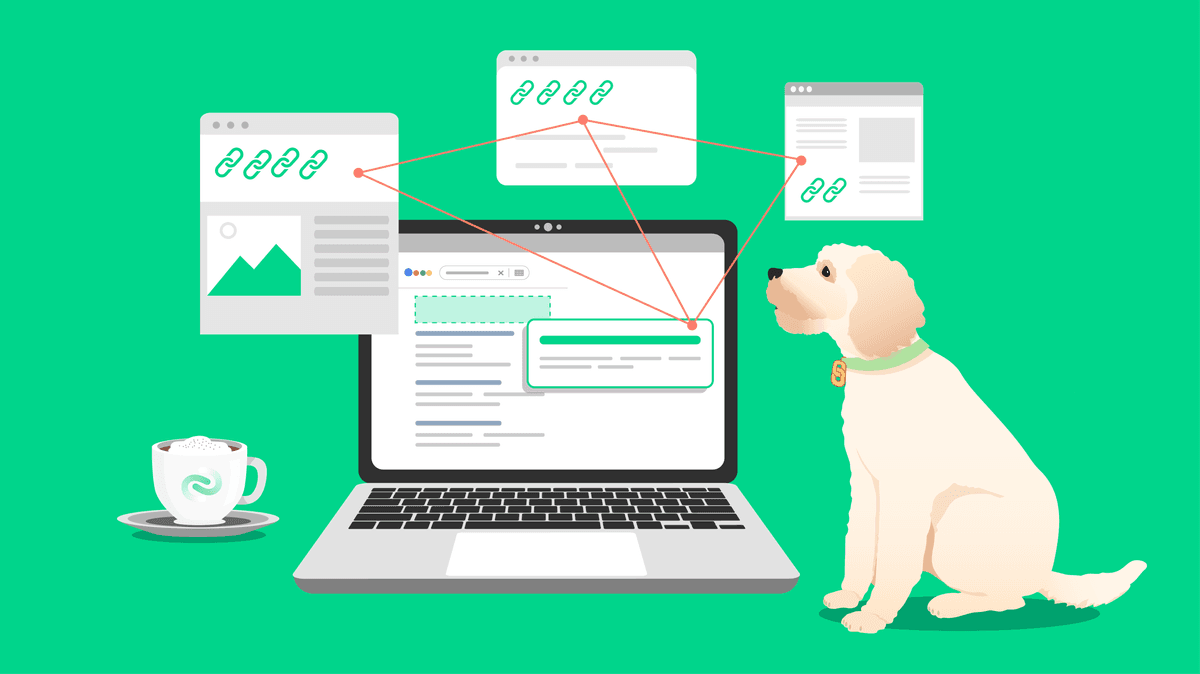
PBNs used to be an effective way to move up in the rankings until Google cracked down on them in 2014.
Some people who own networks that Google hasn’t yet discovered are still able to build sites that contain them. But in the long run, there’s a good chance that the search engine will discover the PBN and penalize the site accordingly.
However, the type of PBN links most people come across are those sold by spammy link builders.
These links exist as a result of a service that promises a high number of links at a low cost or through an outreach email that offers links on a selection of sites.
In the example below, the Fiverr seller is offering 40 backlinks from a PBN with a guaranteed DA score increase of 25. If you think this seems too good to be true, you’d be right.
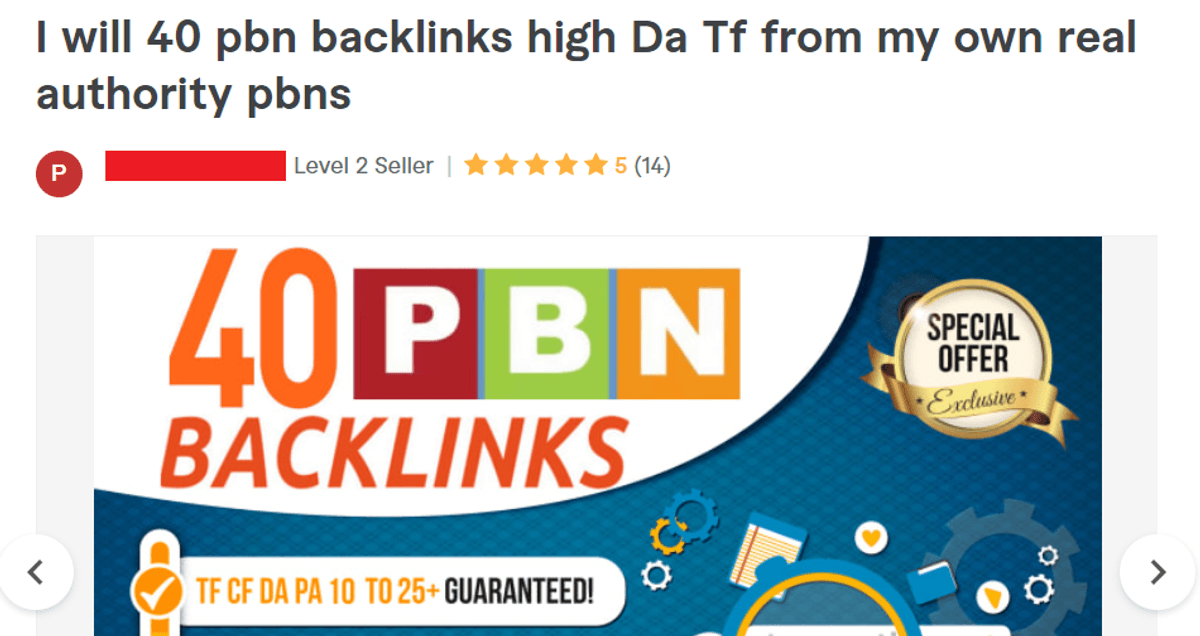
A service like this one promises a high number of links on authoritative websites, which can be tempting if you don’t know it involves a PBN.
The sites that form part of such networks are likely to have long lost any authority they may have once had.
They offer no SEO value and are simply a way for their owners to make money by selling spammy links to unsuspecting business owners.
How to spot PBN backlinks
PBN links are generally easy to spot.
You just have to remember that building links right is a time-consuming and labor-intensive process, and you should be suspicious of anything that goes against this.
If a service claims it can easily generate links, those links are probably from PBNs.
Tell-tale signs that a website is a part of a PBN include:
Outgoing links to a high number of sites
Low organic traffic
Re-directs from other domains
Fast turnaround for link placement (little effort required)
Sometimes services that sell these links will be open about the fact that they are selling PBN links. It’s good that these people are being honest, but it doesn't mean their links will benefit your website.
If you’re worried that your site already contains PBN links, there are some signals to look out for.
Use an SEO tool like Ahrefs to see all your backlinks and then search for signs like:
Sites with a similar or templated design
Sites with a similar backlink profile
Low-quality content and images
A high number of suspicious outgoing links
PBN link rating: Avoid 🚩🚩🚩
PBNs generate some of the worst links out there. Avoid them at all costs. If you think your site has PBN links, disavow them in Google Search Console.
2) Link Farms
Link farms are websites that exist only to link to other sites. Like PBNs, these websites are used by link sellers to make money selling spammy backlinks to unsuspecting website owners.
These websites are often built on expired domains, which means they have good domain metrics on SEO tools. You may have to look beyond these metrics to identify bad backlinks on link farms.
You can look for signs such as:
Poorly written content
An over-reliance on stock imagery
Simple template designs
Lack of an ‘About’ page or contact information
Articles and categories on multiple different topics
Lots of guest posts and guest authors
Posts with suspicious keyword match anchor text
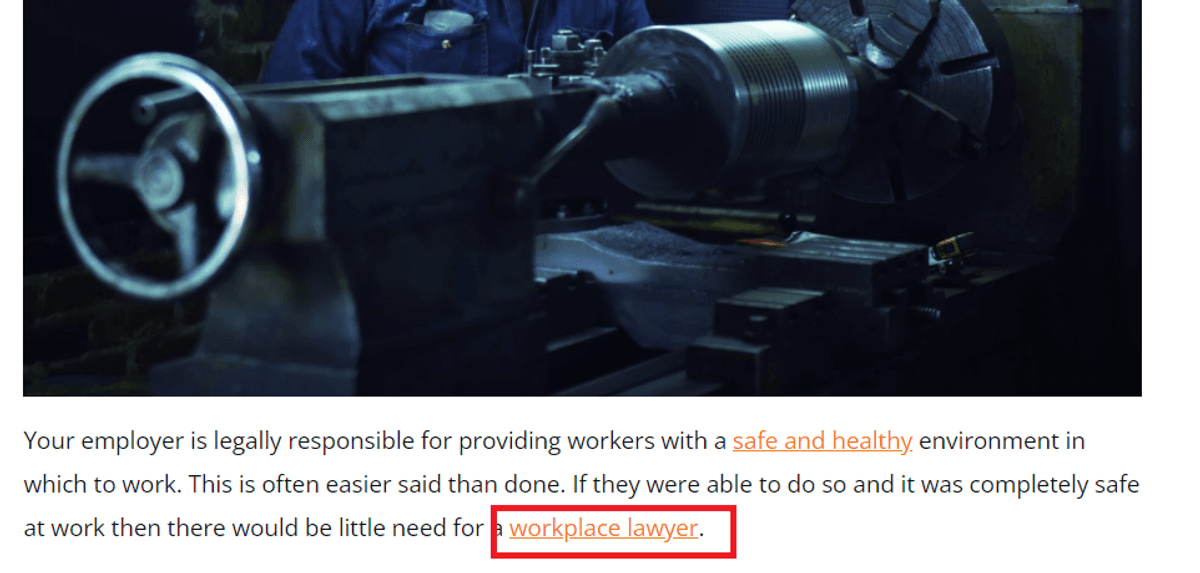
Basically, if you look at a website and wonder why anyone would come to it for the content, there’s a good chance it involves a link farm.
Link farm link rating: Avoid 🚩🚩🚩
Link farm links are low quality and it’s unlikely that they’d positively impact your rankings. Avoid generating these links at all costs, because you’re certain to waste your time and money.
It’s not necessarily a total disaster if your website already features a small number of these links, as Google’s algorithm will probably just ignore them.
However, if you have many and you’re worried that the links are impacting your rankings, you can try disavowing them manually (more on that later).
3) Blog Comment Links
Comment links are those left in the comment section of articles on other websites. Such links are typically included in the comment body or signature.
When done well, these links are related to the articles’ content. They may even provide some value to the people reading them. In this case, they aren’t necessarily spam.
But often, comment links are completely random and offer no value whatsoever—at this point, they are considered link spam.
This type of link exists because it’s free to leave blog comments on other websites. You can also buy software that can automate adding comments on thousands of blogs, which makes them easy to generate.
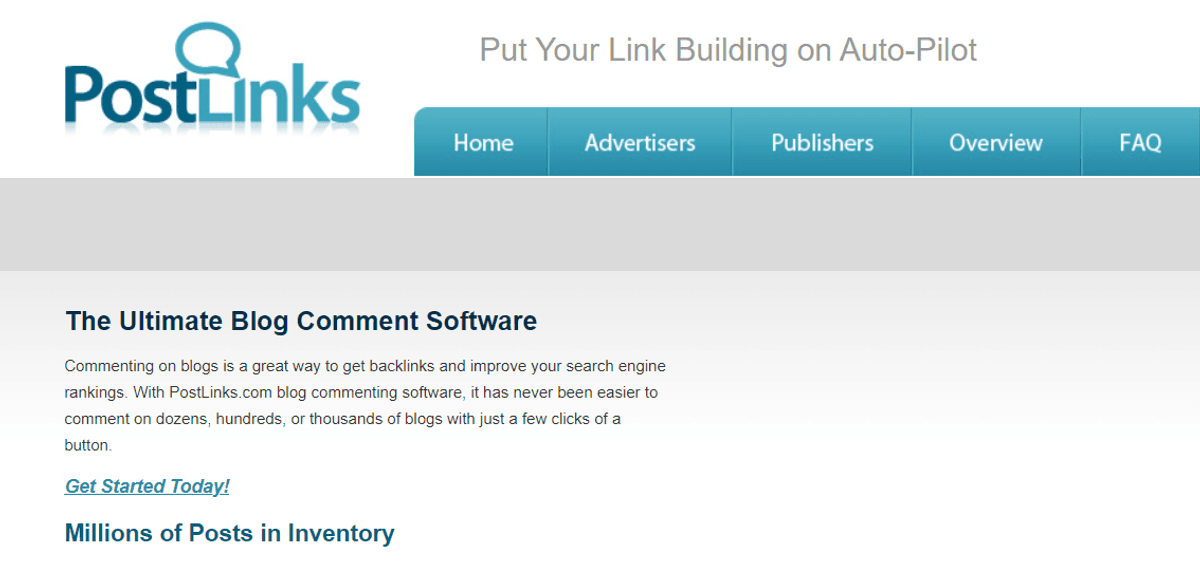
Commenting is a link-building tactic that is as old as SEO itself—but it hasn’t been effective for a long time.
Comment links are typically nofollow, which means Google’s algorithm will ignore them when crawling websites. Even if you find a website that offers dofollow comment links, it’s likely that Google has discovered it and knows to ignore these links.
The good news is that services selling comment links will typically advertise the fact that that’s what they do. The links will be offered at a very low cost and these services typically promise a high volume of links in a short period.
This makes them easy to avoid.
Comment links rating: Mostly harmless 🚩
You definitely want to avoid using any form of mass blog commenting service or software to generate links to your site. You’ll waste both your time and money.
Comment links are almost always nofollow and Google’s algorithm is pretty good at ignoring them.
This means that if your backlink profile has a large number of nofollow blog comment links, it’s usually okay to leave them.
4) Forum Links
Forum links are those from discussion forums and community sites like Reddit, IndieHackers, or StackExchange.
These come in two categories:
The good kind of forum link is when people organically share your content because they find it useful or interesting. This type of content can generate a lot of positive interaction. See the screenshot below for an example:

The bad kind of forum link is when you post links to your site on multiple forums without considering whether doing so benefits the people who will see it. This type of content will usually be ignored.
To be clear, neither type of forum link offers any SEO benefit. These links are typically nofollow and Google’s algorithm is good at ignoring them.
While the first kind of link can positively impact factors like brand building and traffic, the second won’t do any good and is more likely to annoy the people who are part of these communities.
Services that sell forum links will often be upfront about what they are doing, making them easy to avoid.
Forum links rating: Mostly harmless 🚩
These links don’t offer any SEO value and they are mostly harmless. Unless you or a previous site owner has been abusing forum links to a great extent, you can leave them in place.
5) Press Release Links
Press release links are those placed in press releases.
These links aren’t always bad: there’s nothing wrong with adding a link to a press release, and it can be a good way to provide more information about your business, products, or services.

It can even have some indirect SEO value. If other publications pick up your story, they may add the link in the press release to their story.
But press release links are a bad idea if your strategy is to upload the press release to a free distribution website for the sole purpose of generating a backlink from the website.
This has little SEO value, as these sites typically only offer nofollow links.
In this case, issuing the press release is more about trying to manipulate your search engine rankings than sharing company news.
Press release links rating: Mostly harmless 🚩
Press releases can be a useful tool for sharing company news. But they aren’t a good source of backlinks.
Search engines will either ignore these links or penalize sites that abuse them.
6) Spammy Directory Links
Directory links are those that come from business listing websites. Yelp and Foursquare are two popular examples of directories you’re probably aware of.
There are also plenty of industry or location-specific directories you can list your website on.
This type of link has much in common with forum and press release links: they can add some non-SEO value to your website when done right, but they can also result in penalties if you abuse them.
Here’s an example of directory links done well:
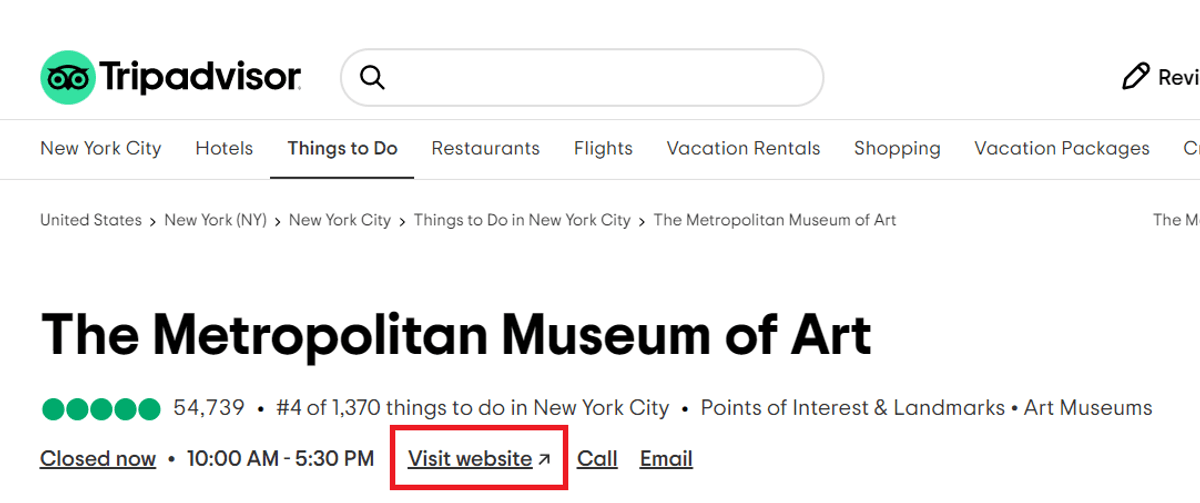
Adding your business website to TripAdvisor will increase your exposure on the platform. You may generate customers when people find your listing on the site.
These links may even have a very small amount of SEO value, as they help search engines understand your business.
But there are plenty of ways that directories could attempt to manipulate the system.
Many directories with little traffic exist only to sell listings to business owners. Listing your website on these sites will offer no SEO or indirect value and can result in penalties.
Directory links rating: Use sparingly 🚩
You should use free directories only when it makes sense for your business.
Adding your business to legitimate directories that focus on your niche can increase business exposure and may even help Google learn about your business.
However, using directories as a form of link-building by adding your site to multiple unrelated, low-quality directories is a bad link-building strategy.
In fact, Google explicitly advises against building links on low quality directories in its Search Central Guidelines.
7) Paid link schemes
Paid link schemes involve exchanging money for backlinks with the goal of improving your ranking in search engine results pages.
While this might sound like a quick way to boost your SEO, it's against Google’s guidelines. Despite this, buying links is not an uncommon link-building activity.
For example, many bloggers with high domain authority and a large following may offer to place a link on their site in exchange for a fee.
Paid links can be safe if you buy them sparingly and not as part of a paid link scheme. Your link must deliver value to readers. If done right, it can be a good way to increase your brand’s exposure and drive traffic to your site.
Paid links rating: Use sparingly 🚩
Using paid links occasionally offers some benefits. Over-relying on paid links, especially from irrelevant or low-quality websites, can lead to penalties that damage your search rankings and overall SEO efforts.
8) Link Exchange Schemes
Link exchange schemes involve two or more website owners agreeing to link to each other’s sites, often with the goal of boosting their search engine rankings.
While exchanging links can seem like a straightforward way to build backlinks, it comes with potential risks.
Google’s guidelines discourage excessive link exchanges done purely for SEO purposes. Note that Google's guidelines use the term "excessive" to describe link exchanges that are problematic.
This suggests that occasional, relevant link exchanges—i.e., those done transparently and for the right reasons—are not inherently against Google’s policies.
The key is moderation and relevance.
Link exchange rating: Use sparingly 🚩
Engaging in link exchanges with relevant and high-quality websites can be beneficial if done thoughtfully.
Ensure that these links provide real value to users and are not just attempts to game the system. For example, partnering with a respected site in your niche can enhance the user experience and help both sites.
However, relying too heavily on reciprocal links can be risky. Your link-building strategy should always be diverse and not become overly dependent on reciprocal link building.
How to Remove Toxic Backlinks ❌
Most of the time, search engines will ignore any toxic links on your website. But in rare cases, bad links can result in a manual penalty.
Google suggests that "if you have a considerable number of spammy, artificial, or low-quality links pointing to your site" you should disavow these backlinks.
If you have received a manual penalty or you think you are at risk of being issued one, you can tell Google to ignore potentially toxic backlinks with Google’s disavow tool.
To do this, you just need to create a .txt file with a list of the domains or subdomains that you want to disavow.
You then upload the disavow file to the Google Search Console disavow links tool. You can find detailed instructions on Google Search Console’s support pages.
How to Avoid Bad Backlinks
As you’ve seen in this article, the majority of bad backlinks are those that are easy for anyone to generate, and some of these bad backlinks only actually become a problem when used excessively.
This means avoiding bad backlinks when building them yourself is as simple as following these steps:
✅ Ask yourself whether anyone can generate backlinks on this site—if so, it's likely not worth having.
✅ Assess whether the backlink may be from a PBN or link farm.
✅ Ask yourself whether the link has a use beyond trying to manipulate search results.
Related problems might arise if you use a third-party service or freelancer to generate links for you. In this case, you're putting your trust in them to create high-quality (or low-quality) links on your behalf.
This is why you need to understand how to identify a bad backlink and challenge them if necessary.
To find a good link-building service, we advise avoiding suspiciously cheap businesses, those that offer guaranteed links on specific websites, and those that lack credible testimonials or case studies.
You can find out more about how to outsource link building in this article.
Or Let Us Build High-Quality Links for You 🚀
At LinkBuilder, we have a proven track record of building high-quality links for ambitious brands. You can find out more about our results on our case studies page or get in touch to see how we can help.

